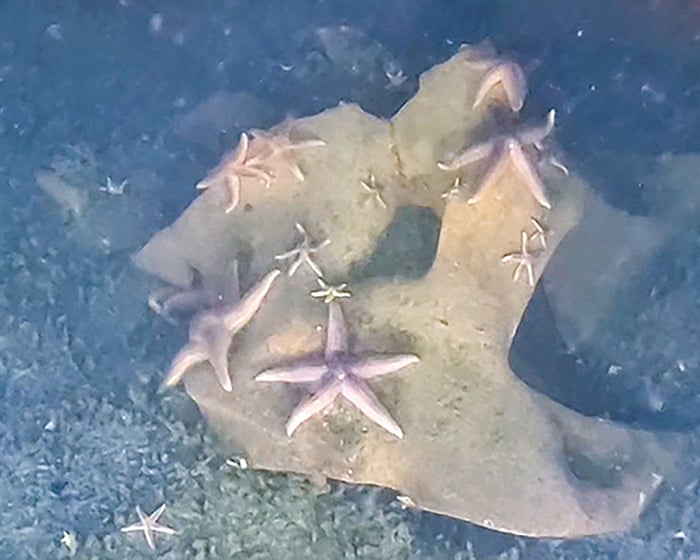Off the German coast, in the brackish waters, lies a wasteland of Nazi-era bombs, torpedoes, and mines. Dumped from barges after World War II and left forgotten, these thousands of munitions have become tangled together over time, forming a rusting carpet on the shallow, muddy seabed of the Bay of Lübeck in the western Baltic Sea.
For decades, this Nazi arsenal was ignored and overlooked. Meanwhile, more and more tourists flocked to the area’s sandy beaches and calm waters for jet skiing, kite surfing, and amusement parks. Below the surface, the weapons slowly decayed.
When scientists first set out to study the impact of these munitions on the ecosystem, some expected to find a barren, poisoned wasteland with no life at all. Andrey Vedenin, from the Senckenberg Research Institute in Frankfurt, led a team to document for the first time what creatures could survive on the underwater weapons.
What they discovered amazed them. Vedenin recalls his colleagues shouting in surprise as the submersible sent back its first images. “It was a great moment,” he says.
Thousands of marine animals had made their homes among the munitions, creating a thriving ecosystem more densely populated than the surrounding seafloor. This underwater metropolis demonstrated the resilience of life. “It’s truly astonishing how much life we find in places that are supposed to be toxic and dangerous,” Vedenin notes.
In one striking example, over 40 starfish had gathered on a single exposed piece of TNT. They were living on metal casings, fuse pockets, and transport containers just centimeters from the explosive material. Fish, crabs, sea anemones, and mussels were all found on the old weapons. “You could compare it to a coral reef in terms of the abundance of wildlife,” Vedenin says.
The munitions support a regenerated ecosystem where many species, including the otherwise rare or declining Baltic cod, are thriving. According to the researchers’ paper, published in September in the journal Communications Earth & Environment, an average of over 40,000 animals lived on every square meter of the munitions, compared to only 8,000 per square meter in the surrounding area.
Vedenin finds it ironic that “things meant to kill everything are attracting so much life.” He adds, “You can see how nature adapts after a catastrophic event like World War II and how life finds its way back even to the most dangerous places.”
The findings in the Bay of Lübeck reveal a surprising truth about how marine life can repurpose human debris. While “urban sprawl” is usually seen as harmful to nature, underwater the story can be different. Hard surfaces like those provided by munitions offer homes for corals, sponges, barnacles, and mussels, as well as nurseries for fish.
Before the war, this part of the Baltic Sea was rich with boulders and rocky outcrops, but nearly all were removed for construction. Artificial structures such as shipwrecks, wind farms, oil rigs, and pipelines can serve as substitutes, replacing some of the lost habitat. This study suggests that munitions may offer similar benefits, and the explosion of life seen in the Bay of Lübeck could occur in other locations.
Between 1946 and 1948, 1.6 million tons of weapons were dumped off the German coast. Thousands of people loaded them onto barges; some were dropped at designated sites, while others were simply tossed overboard.En route. This marks the first time researchers have observed how marine life has adapted.
The seabed of Germany’s North and Baltic Seas is scattered with munitions from both world wars, including shells once fired by German warships.
This phenomenon isn’t limited to weapons. In the U.S., retired oil and gas structures have transformed into coral reefs through the Rigs-to-Reefs program, which promotes leaving cleaned and stable underwater structures for environmental benefits. Similarly, sunken World War I ships in Maryland’s Potomac River now serve as wildlife habitats.
These sites gain importance for wildlife as oceans face increasing depletion from fishing, bottom trawling, and anchoring. According to Vedenin, sunken ships and weapons sites effectively function as protected zones—not official national parks, but areas where most human activities are banned. As a result, species like the Baltic cod, which are otherwise rare or in decline, are flourishing there.
Vedenin notes that seas near any military conflict zones from the past century are typically littered with munitions, amounting to millions of tonnes of explosive material in our oceans.
Documenting these munitions is challenging due to national borders, classified military data, and records hidden in historical archives. They present risks of explosions, security threats, and ongoing toxic chemical leaks.
Since the 1990s, experts have raised alarms about the “danger from the deep” and the urgency of removing these explosives. Pressure to clear the weaponry has also grown from increasing demands to use the seabed for other purposes, like dredging or offshore projects such as wind farms, cables, and pipelines.
As Germany and other nations begin removing these relics, scientists aim to safeguard the ecosystems that have developed around them. Removal efforts are already underway in the Bay of Lübeck.
Vedenin suggests replacing the hazardous metal remnants of munitions with safer alternatives, such as concrete structures. He hopes the approach in Lübeck will set an example for other areas, demonstrating that even the most destructive weapons can provide a foundation for new life.
For instance, tank tracks from U.S. equipment lost during the 1944 invasion of Guam have become home to coral off Asan beach, showing how remnants of conflict can support biodiversity.
Frequently Asked Questions
Of course Here is a list of FAQs about how discarded underwater munitions become marine habitats written in a clear and natural tone
Beginner General Questions
1 What are underwater arsenals
They are old discarded military weapons like bombs torpedoes and naval mines that have been left on the seafloor often after wars or training exercises
2 How can something dangerous like a bomb become a habitat
Over time these metal objects rust and break down creating nooks crannies and hard surfaces In the vast sandy or muddy seafloor this structure acts like an artificial reef providing a place for creatures to hide live and feed
3 Isnt it dangerous for marine life to live on explosives
Generally yes if the munition is still live and unstable However many have been submerged for decades and are inert The primary danger is physical disturbance that could cause them to explode not the slow leakage of chemicals which is a separate concern
4 What kinds of creatures typically live on these sites
Youll often find a wide variety of life including algae barnacles anemones corals octopuses lobsters and many species of fish that use the structures for shelter
5 Are these weapons removed for safety
Sometimes but removal is often riskier than leaving them in place The process can be expensive technically challenging and could detonate the weapon causing more harm to the ecosystem Often they are monitored and left undisturbed
Advanced Detailed Questions
6 What is the main environmental risk of these sunken munitions
The biggest risk is the potential release of harmful chemicals as the metal casings corrode This can include explosives like TNT and chemical warfare agents which can poison the water and sediment affecting marine life
7 Can you give a famous example of an underwater arsenal turned habitat
Yes a great example is the Bikini Atoll in the Pacific Ocean After nuclear tests numerous warships were sunk and they are now thriving coral reefs teeming with marine life despite the residual radioactivity
8 How does this process compare to purposesunk artificial reefs like old ships
The ecological process is identicalboth provide a hard substrate for life to colonize The key




